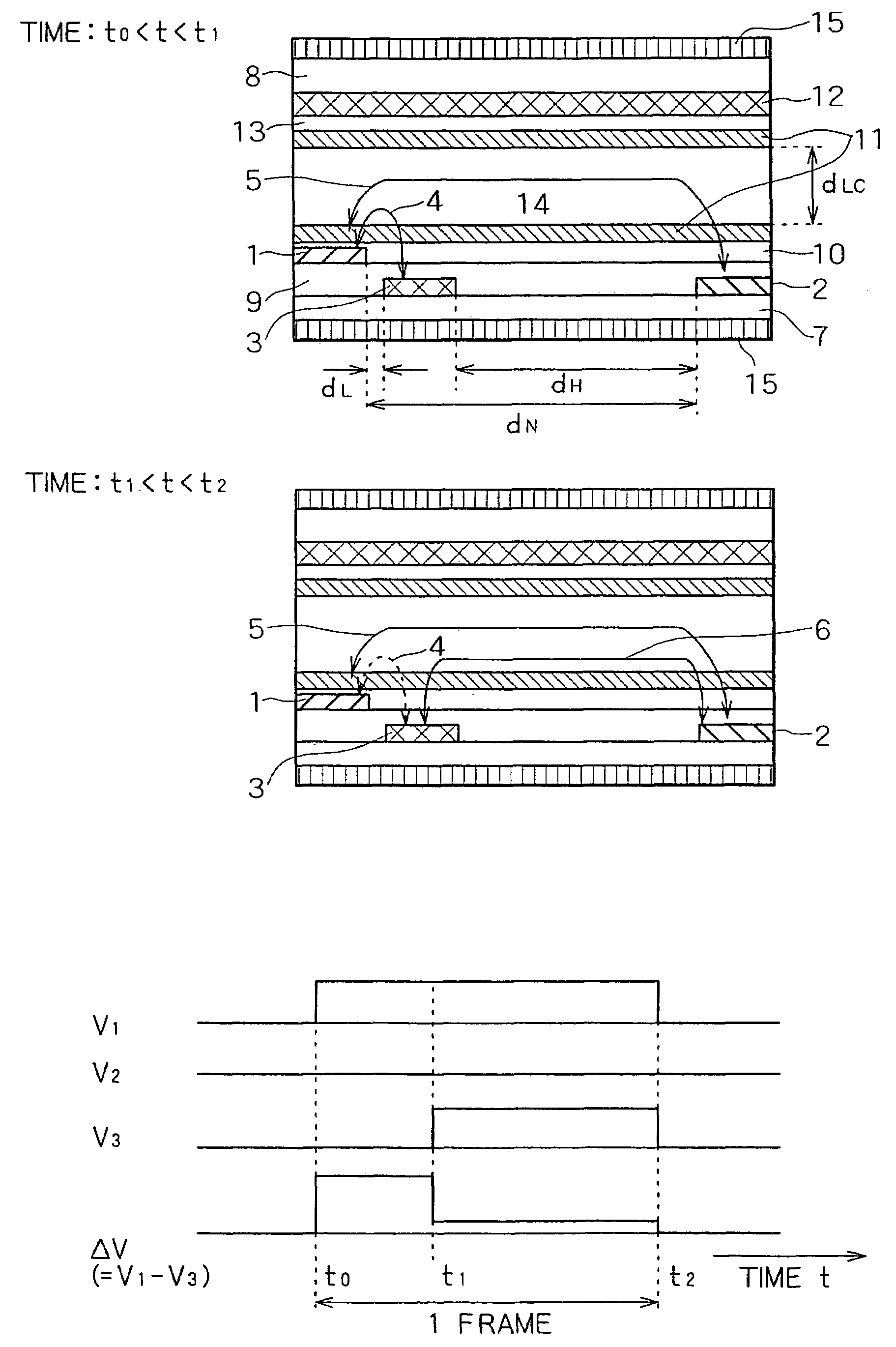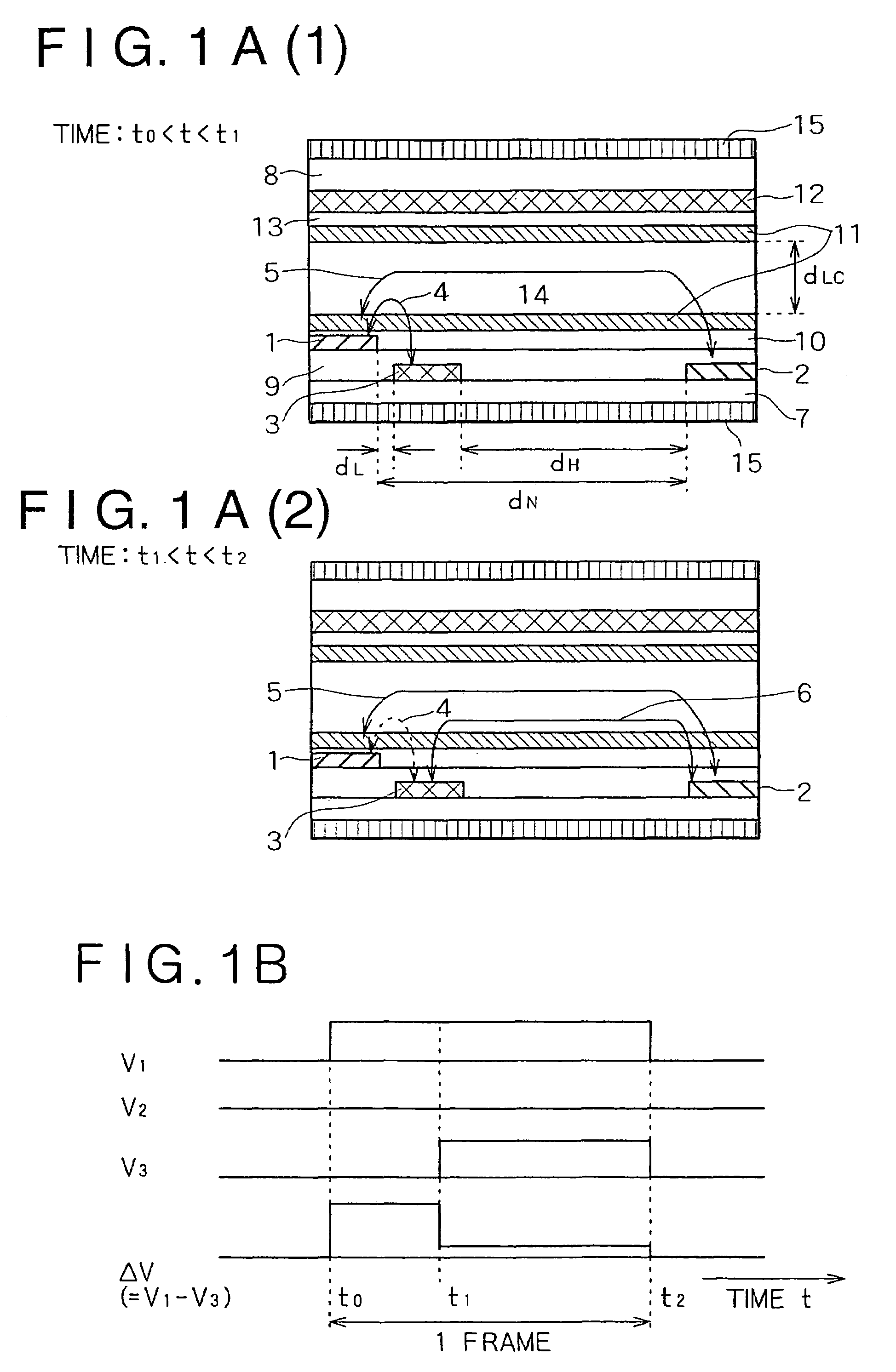Liquid crystal display panel, liquid crystal display device, and liquid crystal television
- Summary
- Abstract
- Description
- Claims
- Application Information
AI Technical Summary
Benefits of technology
Problems solved by technology
Method used
Image
Examples
embodiment 1
[0090]The arrangement according to Embodiment 1 will be explained with reference to FIGS. 3, 4, 5, 6, 7A and 7B. FIG. 3 illustrates the electrode structure of a pixel portion in a liquid crystal display panel according to Embodiment 1. FIG. 4 is a cross-sectional view showing the pixel portion in the liquid crystal display panel according to Embodiment 1. FIG. 5 shows the signal waveforms of signals supplied to the different electrodes and lines shown in FIG. 3. FIG. 6 is a schematic diagram showing the overall structure of the liquid crystal display device having these pixel structures. For the purpose of this specification, the term “liquid crystal display panel” is used to refer to a device which includes a pair of substrates, a liquid crystal layer, electrodes disposed on the pair of substrates, and the like, as shown in FIGS. 1 and 4, and the term “liquid crystal display device” is used to refer to a system combining the liquid crystal display panel, a light source, and the lik...
embodiment 2
[0113]The arrangement of a second embodiment according to the present invention will be explained with reference to FIGS. 10 and 11. FIG. 10 includes diagrams of the electrode structure of a pixel portion. FIG. 11 shows the signal waveforms supplied to different electrodes and lines disposed as shown in FIG. 10.
[0114]The arrangement of a liquid crystal display panel according to Embodiment 2 differs from that of the liquid crystal display device according to Embodiment 1 in that a third electrode 107 and a pixel electrode 106 are superposed on each other. Because of this configuration, the pixel electrode 106 must be disposed on a layer above the layer on which a first signal line 104 is disposed; and, as shown in FIG. 10B, the pixel electrode 106 is disposed on an even higher layer by way of a through-hole 113, being superposed on the third electrode 107. Since the third electrode 107 is superposed on the pixel electrode 106, signal waveforms supplied to different electrodes and li...
embodiment 3
[0122]The arrangement of a third embodiment according to the present invention will be explained with reference to FIGS. 13, 14, and 15. FIG. 13 shows a view of the electrode structure of a pixel portion. FIG. 14 shows signal waveforms supplied to different electrodes and lines. FIG. 15 is a schematic diagram showing the overall structure of the liquid crystal display panel having these pixel structures.
[0123]The arrangement of the liquid crystal display panel according to Embodiment 3 differs from that of the liquid crystal display device according to Embodiment 1 in that two TFTs disposed within one pixel are driven by one scanning line. The reduction in the number of scanning lines by one from the arrangement according to Embodiment 1 yields the effect that a second scanning line driver is no longer necessary.
[0124]As shown in FIG. 13, the electrode structure according to Embodiment 3 is provided with two TFTs, one scanning line, and two signal lines in order to drive one pixel. ...
PUM
 Login to View More
Login to View More Abstract
Description
Claims
Application Information
 Login to View More
Login to View More - R&D
- Intellectual Property
- Life Sciences
- Materials
- Tech Scout
- Unparalleled Data Quality
- Higher Quality Content
- 60% Fewer Hallucinations
Browse by: Latest US Patents, China's latest patents, Technical Efficacy Thesaurus, Application Domain, Technology Topic, Popular Technical Reports.
© 2025 PatSnap. All rights reserved.Legal|Privacy policy|Modern Slavery Act Transparency Statement|Sitemap|About US| Contact US: help@patsnap.com



